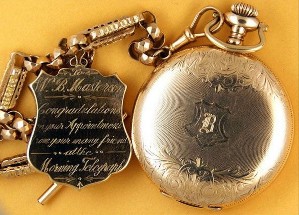
NEW YORK – Remember those tiny pockets-within-pockets in Levi jeans? They apparently hark back to the 1600s, when Charles II introduced waistcoat-vests (harbinger of three-piece suits) to Great Britain. Instead of secreting keys or coins, their multiple fob-pockets (likely named for fuppes, “small pockets” in Low German), boasted classy new gadgets – sleek, flat, elegant “pocket-watches.”
As fashions changed, these were slipped in breech-waist fob-pockets. These were large enough to insert a finger or a timepiece – but not both. So short, handy tassels or ribbons – called fob chains – were added. In time, each dangled a small, convenient trinket-pull. These are called watch fobs.
Though visible watch fobs served their purpose, wrote Franklin J. Didier in 1818, they also emboldened pickpockets. With a single, sharp tug, they could abscond with the goods.

Some fobs, watch-keys (for winding) and seals to secure important letters and documents, were functional. Others, dangling singly or in multiple groupings, were purely decorative.
Through the Victorian Era, ornate fobs, linked to metal or woven human or horse-hair chains, adorned watches, bracelets and brooches. These stylish accessories also made coveted gifts. Chased, scrolled, openwork or embossed gold fobs often featured personal monograms or intricately carved citrine, onyx, jade or agate intaglios. Dramatic swivel or pendant models featured large, metal-mounted amethysts, bloodstones, or carnelians. Bright enamel ones bore foliate and floral designs swirled with delicate diamonds or pearls. Novelties, like heart, horse hoof, watch dial face, and compass-shaped fobs, were also charmers.

Toward the turn of the century, watch fobs were not only purchased, but awarded as prizes. British garden clubs, for example, acknowledged floral achievements, like “best-in-lilies” or “best-in-roses,” with finely engraved silver or gold models. Sport clubs bestowed themed fobs at racing, shooting, curling, golfing and billiard events.
Watch fob fever also swept America. When tailor-made shirtwaist dresses became fashionable,” wrote the Baltimore America in 1899, women who prided themselves on “smart dressing” enhanced their trendy gold watch-slides with tiny, fob-lockets, seals or medallions. Wealthier women, however, preferred gemstone or openwork gold fobs, and later, enticing platinum, diamond and onyx Art Deco confections.

As the American working classes acquired pocket watches, salesmen doled out scores of inexpensive brass, bronze-tone, nickel-plate or celluloid advertising fob giveaways. Many featured engraved dates, names, and initials on one side, backed by recognizable product depictions or logos on the other – for those who could not read. Others, making product identification simpler still, were shaped like the item they promoted, be it bulls, cows or Caterpillar tractors. Giveaway fobs also plugged everything from chewing tobacco to Magnolia brand molasses, Vin Fiz sparkling grape drink, and Coca-Cola.

In addition to showing status and style, watch fobs also proclaimed allegiance to fraternal organizations like the Freemasons, Odd Fellows and the Knights of Pythias. Those created for the Benevolent and Protective Order of Elks, each featuring a genuine, polished elk tooth, however, were controversial. By 1902, they were apparently so popular that President Theodore Roosevelt, fearing herds would be slaughtered to oblivion, convinced the organization’s Grand Exalted Master to forbid their production.

As tourism expanded, souvenir watch fobs marked trips to Salt Lake City, Mount Rushmore, Pikes Peak and beyond. Some commemorated notable events like the 1914 Copper Miles City Roundup, the 1904 St. Louis Louisiana Purchase Exposition, or the 1906 Chicago White Sox World Championship. Patriotic models displayed flags, state seals, campaign slogans or images of presidential candidates. Yet one-of-a-kind fobs traced to actual historic figures, like John Quincy Adams or Bat Masterson, are far more collectible.
As wristwatches replaced pocket watches after World War II, watch fobs slowly fell from use.
Today, some are repurposed into unique charm bracelets or necklace-pendants. Others, whether history buffs or dapper dressers, slip fobbed watches into tiny pockets-within-pockets of their jeans.
# # #


